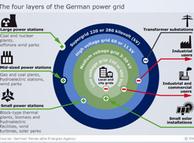
Posted on 07/29/2014 6:26:20 PM PDT by Lorianne
MUNICH, Germany -- Offshore wind is the key to the European Union's commitment to a legally binding target to meet 20 percent of its energy consumption through renewable energy by 2020. Under plans submitted by E.U. member states, as much as 43.3 gigawatts of offshore wind capacity is supposed to be deployed by 2020.
But the pace of installation is falling well behind this ambitious target -- roughly the equivalent of 40 large electric generating plants. The gap is 14 percent at the moment, according to the European Wind Energy Association (EWEA), with France and Germany, in particular, significantly behind.
The high level of uncertainty that comes with changing regulatory frameworks as well as some technical problems involving grid upgrades have slowed down offshore wind energy deployment in Germany. Meanwhile, in France, offshore wind tenders were slow to take off and didn't attract a wide range of bidders because of the high level of locally manufactured content required.
According to their National Renewable Energy Action Plans (NREAPs), the two countries were supposed to have installed 670 and 790 MW, respectively, by the end of 2012. Instead, as of December last year, France had no offshore wind at all and Germany had 385 MW, the EWEA said.
Delays in building the transmission lines to connect offshore wind farms have pushed back the commissioning dates of a number of wind projects in Germany. TenneT, the transmission system operator in charge of connecting German offshore wind farms in the North Sea, put on hold any new agreements for grid connection of German offshore wind plants between 2011 and 2013.
Germany's Economy Ministry conducted a study that says the idea of paying utilities to keep enough capacity on the grid to support fluctuating flows of energy from wind and solar power plants interferes "strongly with the power market and entails significant regulatory risks" and may drive up costs.
So far, most of the investments in offshore wind farms have been made by major utilities, with 72 percent, according to the EWEA. Institutional investors like Danish pension fund PensionDanmark have accounted for 6 percent of the funds, oil and gas companies like Statoil account for 5 percent, and corporate investors like Marubeni and Mitsubishi 3 percent.
German connections slow, finances troublesome
Germany has pledged to phase out its nuclear reactors by 2022, and the country's utilities lobby has been asking for such payments, arguing that the country faces electricity shortages as early as 2017. Germany needs about 4.8 GW of backup power for the winter of 2015 and 2016, for which the grid regulator will sign contracts with utilities.
The utilities are scheduled to start new plants fired by gas and coal totaling a combined capacity of 6.9 GW by the end of next year, but this capacity could be unprofitable if renewable energy is available at peak demand times, such as at midday on a sunny day in the case of solar power or nearly around the clock in the case of offshore wind from the North Sea.
In April, Germany's government approved a reform of its renewable energy law to slow down the expansion of green energy and the rise in electricity costs. The bill, which is expected to come into law next month, caps offshore wind expansion at 6.5 GW to 2020.
That leaves a long way to go to 54 GW of offshore wind farms by 2050, which is the amount that the country will need to reach its target of getting 80 percent of its power from renewable energy, according to a study published by the Fraunhofer IWES research institute.
If all available offshore wind locations in the German sectors of the North and Baltic seas were used, the industry would produce 258 terawatt-hours of electricity per year, most likely generating power on 340 days a year, with low volatility, according to the study.
The Renewable Energy Act amendments also introduced a sliding support rate for new offshore wind projects to 19 euro cents per kilowatt-hour in 2015, 18 cents per kWh in 2018 and 17 cents per kWh in 2019 instead of the previous flat rate of 19 cents per kWh until 2019.
"We forecast a capacity of 6.9 GW in line with the proposed government target," said Charanjit Singh, a renewable energy analyst at HSBC Bank.
[snip]

Europe has pioneered large-scale offshore wind farms to switch power grids to clean energy, but governments are beginning to cut helpful subsidies.
Ping.
Wow!
What a wonderful idea for another EO by Zer0 to fund more zero payback windfarms in the US!
They started sanctions of Russia today. It would behoove them to get in gear on alternatives. In a few short weeks, it’ll get a little chilly.

Frickin scam for the entire supply chain and investors.
It behooves the civilized world in general to get it in gear on alternatives. Once Russia and the various Psychotistans don't have a viable market for their fossil fuels, they'll calm down... or, if they don't calm down, their capacity to make trouble will be greatly curtailed.
Disclaimer: Opinions posted on Free Republic are those of the individual posters and do not necessarily represent the opinion of Free Republic or its management. All materials posted herein are protected by copyright law and the exemption for fair use of copyrighted works.